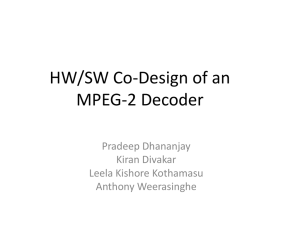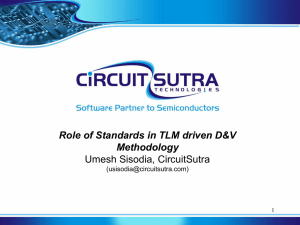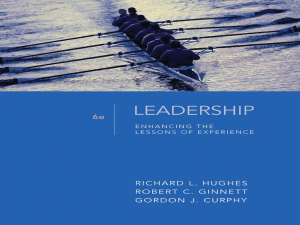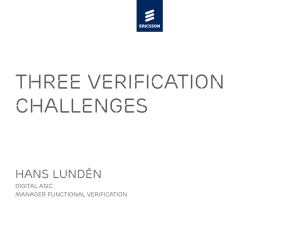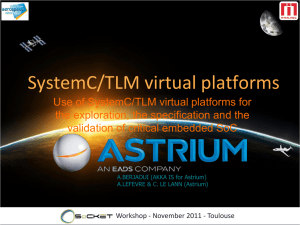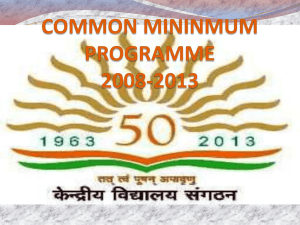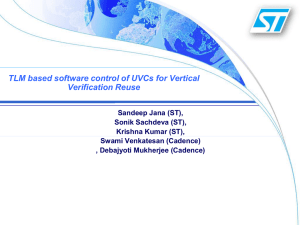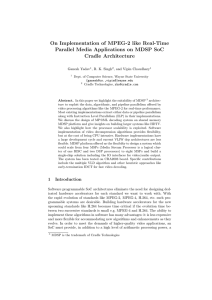Sample Presentation 1
advertisement
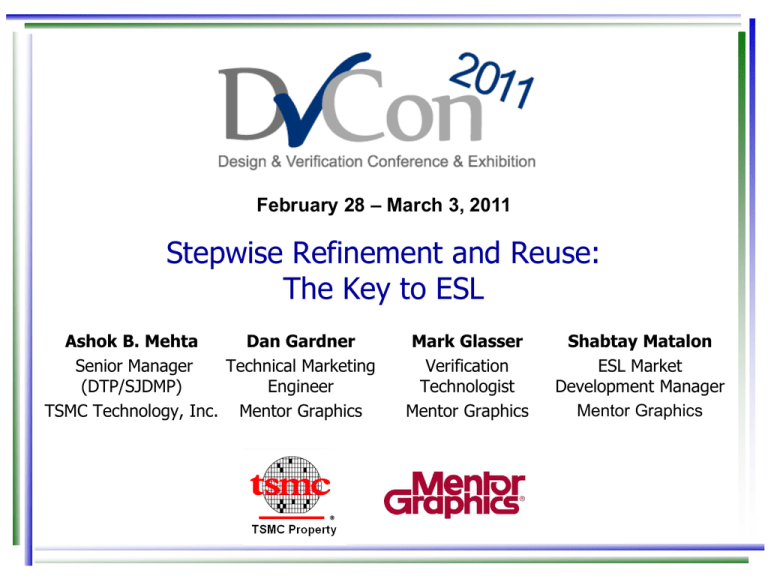
February 28 – March 3, 2011 Stepwise Refinement and Reuse: The Key to ESL Ashok B. Mehta Dan Gardner Senior Manager Technical Marketing (DTP/SJDMP) Engineer TSMC Technology, Inc. Mentor Graphics Mark Glasser Verification Technologist Mentor Graphics Shabtay Matalon ESL Market Development Manager Mentor Graphics Trends … • 15 billion connected devices by 2015 • Basic + Smart + Enhanced phones = 2 billion phones by 2012 • Mobile processor clock speed > 1 GHz (32 nm HKMG) • Smart phone > 200 million triangles/sec by 2011 • Highly integrated devices with audio, video, 3D graphics, text connected to Internet; require long battery life • Marvell’s ARMADA 628 SoC – 1.5 GHz tri-core processor – dual stream 1080p 3D video – 3D graphics performance with 200 million triangles per second – for ultra-low-power, long battery life smartphones and tablets 2 of 19 Trends … Rapid proliferation of MP-SoC with multiple concurrent software applications 2010 2012 Source: Next Generation Embedded Hardware Architecture - VDC 2010 3 of 19 It’s a struggle … It’s a development struggle It’s a power struggle Source: The International Technology Roadmap for Semiconductors (ITRS), 2008 Update) Power requirement vs. power trends Cost of design tasks per technology 4 of 19 Current Reality … Source : Semiconductor Industry Association. International Technology Roadmap for Semiconductors Chip complexity versus design productivity 5 of 19 ESL Verification Flow – Why? • Transaction-level models (TLM) allow designers to: – Build platforms for software development and hardware architecture exploration before committing to RTL – Manage the complexity of sophisticated large-scale SoCs – Build and verify SoCs more quickly – Run simulations orders of magnitude faster than RTL • Reuse TLM as RTL verification testbench component • Standards-driven: OSCI TLM, SystemC, C++, OVM, SystemVerilog 6 of 19 ESL Verification Flow Benefits • Demonstrates verification methodology early in the design before RTL is created or synthesized – Designers can validate their design specification at the TLM – Verification engineers can reduce RTL verification effort by starting validation at the TLM • Common design and testbench throughout the flow, from C++/SystemC to RTL – Design block and stimulus reuse 7 of 19 MENTOR SOLUTION (release on TSMC-online) TSMC REFERENCE FLOW 11 8 of 19 Design Example – IDCT + AXI IDCT 11-bit signed IDCT_H REGFILE PP0 REGFILE PP1 IDCT_V 8-bit signed AXI Slave AXI Bus • Inverse Discrete Cosine Transform (IDCT) – design block used in JPEG/MPEG • Design example connects IDCT to AXI bus (slave) 9 of 19 Stage 1: Algorithmic • Model represented in pure C++ • Verified using C++ testbench User-created C++ Stimulus Generator User-created C++ IDCT Model 10 of 19 Stage 2: Transaction Level Model • Algorithmic models transformed to SystemC transaction-level (from Stage1) models – TLM2.0 for interface protocol C++ Stimulus Generator Vista Model Builder – Timing/Power policies added • TLM assembled to create the Stimulus Generator TLM User-created User-created (from Stage1) SystemC/TLM2.0 provides standard interfaces for communication between models transaction-level platform SystemC model C++ IDCT Model Vista Model Builder C++ Stimulus Generator IDCT TLM C++ IDCT Model T P 11 of 19 Stage 2: Transaction-Level Validation, Debug, and Coverage • Vista simulation and debug are used to validate results – Transaction View – SystemC Process View • Coverage collector TLM determines if TLM DUT sufficiently exercised Validate & Debug in TLM Domain Stimulus Generator TLM C++ Stimulus Generator IDCT TLM C++ IDCT Model Vista Coverage Collector TLM 12 of 19 Stage 2: Preparing for Reuse in OVM • TLM1TLM2 translator added • TLM DUT verified in a TLM1.0 configuration on Vista or Questa • IDCT TLM is now ready for reuse as a reference model in OVM TLM1 TLM2 translator Stimulus Generator TLM TLM1.0 wrapper C++ Stimulus Generator Function IDCT IDCT TLM TLM C++ IDCT Model Vista or Questa TLM2.0 wrapper 13 of 19 Stage 3: High Level Synthesis and Verification • Starting point of the design is fixed-point C++ or SystemC • User-created C++ testbench is reused throughout the flow • Catapult synthesizes C++ design to RTL and creates transactors • • Transactors convert function calls to pin-level signal activity and vice versa Comparator compares RTL DUT output against the C++ model output C++ Stimulus Generator User-created testbench Driver Usercreated IDCT design block C++ IDCT Model Catapult SCVerify automated verification flow IDCT RTL Block Monitor Comparator Golden results DUT results 14 of 19 Stage 3: OVM Block Testbench • IDCT agent drives the DUT – – – • Sequence Interface: Host to sequences Analysis Port: makes available the transactions to components outside the agent Virtual Interface: interface object that contains the pins that are on the DUT Other elements – – Sequences: behaviors that generate stimulus for DUT Scoreboard: determines if DUT provides correct response for a given stimulus 15 of 19 Stage 4: Bus Integration • Adds AXI interface to Stage 3 • Reusing IDCT TLM + IDCT agent • Demonstrates whitebox coverage From Stage 3 IDCT Agent in passive mode (active monitor but in-active driver) From Stage 2 16 of 19 Stage 5: System-Level Step • Adds AXI Switch • Enables reuse in a complete system 17 of 19 The ESL Verification Demo Kit in TSMC RF11 Shows: • Verification of C++ IDCT model • Construction of TLM from C++ models • Transaction-level assembly, validation, and debug • Validation of synthesized IDCT block against original untimed C++ model using SCVerify flow • Cross-probe synthesized RTL from original C++ and vice-versa • Reuse of IDCT TLM and C++ stimulus in OVM RTL block-level verification • Reuse of IDCT TLM in OVM RTL block-level verification of the IDCT with AXI slave adapter 18 of 19 Benefits to the Verification Engineer • Early and faster design validation using TLM before RTL • Design and stimulus reuse throughout the flow from C++/SystemC to RTL – No need to maintain different models • Verification early in the design phase before RTL is created or synthesized Mentor ESL Verification Flow Kit for TSMC RF11 is released on TSMC-online 19 of 19

